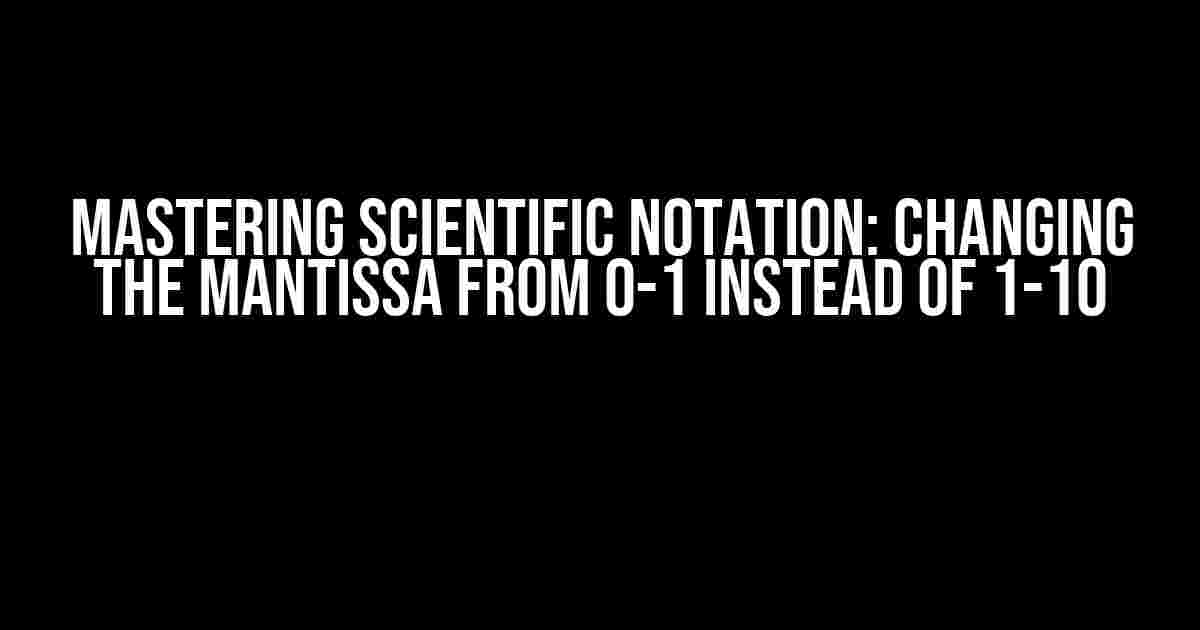Why Change the Mantissa?
- More precision**: When working with very small numbers, having a mantissa between 0 and 1 can provide more precision and accuracy.
- Simplified calculations**: In certain mathematical operations, such as multiplication and division, having a mantissa between 0 and 1 can simplify the process and reduce errors.
- Better visualization**: For visual learners, having a mantissa between 0 and 1 can make it easier to compare and contrast different values.
The Basics of Scientific Notation
- Coefficient (mantissa)**: A number between 1 and 10 that represents the significant digits of the original number.
- Exponent**: An integer that represents the power to which the base should be raised to produce the original number.
a = c × 10^n
a is the original number, c is the coefficient (mantissa), and n is the exponent.
Changing the Mantissa: Step-by-Step Instructions
- Write the original number**: Start by writing the original number you want to convert to scientific notation.
- Move the decimal point**: Move the decimal point to the left until the number is between 0 and 1.
- Count the decimal places**: Count the number of decimal places you moved the decimal point to determine the exponent.
- Write the mantissa**: Write the number between 0 and 1 as the mantissa.
- Write the exponent**: Write the exponent as the power to which the base (10) should be raised.
- Combine the parts**: Combine the mantissa, base, and exponent to write the number in scientific notation.
- Move the decimal point to the left until the number is between 0 and 1: 0.0042 → 0.42 × 10^(-2)
- Count the decimal places: 2
- Write the mantissa: 0.42
- Write the exponent: -2
- Combine the parts: 0.42 × 10^(-2)
Converting Back to Standard Notation
- Take the mantissa**: Take the mantissa (the number between 0 and 1) and multiply it by the base (10) raised to the power of the exponent.
- Simplify the result**: Simplify the result to get the original number in standard notation.
- Take the mantissa: 0.42
- Multiply by the base raised to the power of the exponent: 0.42 × 10^(-2) → 0.0042
- Simplify the result: 0.0042
Common Pitfalls and Troubleshooting
| Problem | Solution |
|---|---|
| Mantissa not between 0 and 1 | Move the decimal point to the left until the number is between 0 and 1 |
| Exponent incorrect | Count the number of decimal places moved and adjust the exponent accordingly |
| Difficulty converting back to standard notation | Double-check the mantissa and exponent, and make sure to multiply by the correct power of 10 |
Conclusion
Frequently Asked Question
Get ready to decode the secrets of scientific notation and master the art of changing mantissas!
Q1: What’s the purpose of changing the mantissa in scientific notation from 0-1 to 1-10?
The main reason is to provide a standardized way of representing very small or very large numbers in a more readable and manageable format. By having a mantissa between 1 and 10, it’s easier to perform calculations and comparisons.
Q2: What’s an example of a number in scientific notation with a mantissa between 0 and 1?
A classic example is 0.5 × 10^3, where 0.5 is the mantissa between 0 and 1. To convert it to the standard form, you’d multiply the mantissa by 2, getting 1 × 10^3, which is a more conventional representation.
Q3: How do you convert a mantissa from 0-1 to 1-10 in scientific notation?
To convert, simply multiply the mantissa by 10 (or any power of 10) until the mantissa is between 1 and 10. For instance, if you have 0.05 × 10^2, you’d multiply the mantissa by 10 to get 0.5 × 10^2, and then again to get 5 × 10^1, which is in the standard form.
Q4: Is it always necessary to have a mantissa between 1 and 10 in scientific notation?
Not always! While it’s conventional to have a mantissa between 1 and 10, there are cases where a mantissa between 0 and 1 might be more suitable, like in certain mathematical derivations or calculations. It ultimately depends on the context and the specific requirements of the problem or application.
Q5: What are the advantages of using scientific notation with a mantissa between 1 and 10?
The main benefits include easier calculations, simplified comparisons, and a more standardized way of representing very large or very small numbers. It also helps in avoiding errors and makes it easier to understand and work with extremely large or small quantities.


